
Perform operations with numbers expressed in scientific notation, including problems where both decimal and scientific notation are used.
- Subject:
- Mathematics
- Material Type:
- Activity/Lab
- Author:
- Liberty Public Schools
- Date Added:
- 04/13/2021

Perform operations with numbers expressed in scientific notation, including problems where both decimal and scientific notation are used.
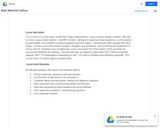
This course is a continuation of MAT087, Basic Mathematics. Topics include signed numbers, decimal numbers, exponential notation, scientific notation, solving and graphing linear equations, an introduction to polynomials, and systems of linear equations and their graphs. Geometrical topics include lines and angles, closed curves and convex polygons, triangles and similarities, and symmetry and proportion in nature and art. Students may complete this course during the first three weeks of the semester by passing the MyMathLab modules. Students will then be eligible to take either MAT 099 Intermediate Algebra, MAT 114-Quantitative Reasoning or MAT 120-Intro to Statistics the following semester. This course does not satisfy degree requirements.
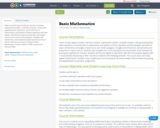
Topics include signed numbers, decimal numbers, exponential notation, scientific notation, solving and graphing linear equations, an introduction to polynomials, and systems of linear equations and their graphs. Geometrical topics include lines and angles, closed curves and convex polygons, triangles and similarities, and symmetry and proportion in nature and art. All course content by Valerie Dietel-Brenneman. Content added to OER Commons by Victoria Vidal.

Topics include signed numbers, decimal numbers, exponential notation, scientific notation, solving and graphing linear equations, an introduction to polynomials, and systems of linear equations and their graphs. Geometrical topics include lines and angles, closed curves and convex polygons, triangles and similarities, and symmetry and proportion in nature and art. Students may complete this course during the first three weeks of the semester by passing the MyMathLab modules. Students will then be eligible to take either MAT 099 Intermediate Algebra, MAT 114-Quantitative Reasoning or MAT 120-Intro to Statistics the following semester. This course does not satisfy degree requirements. Students may complete this course during the first three weeks of the semester by passing the MyOpenMath Acceleration assignments.

As we approach the end of Crash Course Astronomy, it’s time now to acknowledge that our Universe’s days are numbered. Stars will die out after a few trillion years, protons will decay and matter will dissolve after a thousand trillion trillion trillion years, black holes will evaporate after 10^92 years, and then all will be dark. But there is still hope that a new Universe will be born from it.
Chapters:
Introduction: The End of the Universe
Scientific Notation
The Five Ages of the Universe
The Primordial Era
The Stelliferous Era (You Are Here!)
The Degenerate Era
The Black Hole Era
The Dark Era
The Big Rip
Other Possibilities: Multiverses & The Cosmic Reboot
Review
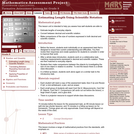
This lesson unit is intended to help teachers assess how well students are able to: estimate lengths of everyday objects; convert between decimal and scientific notation; and make comparisons of the size of numbers expressed in both decimal and scientific notation.

This text includes 25 reading assignments for an introductory astronomy course. They have been modified from the OpenStax Astronomy 2e and College Physics 2e (linked in related resources below) textbooks to order the topics in a logical manner for a one semester course and provide shortened (~10-20 pages) readings intended for biweekly reading assignments. The text also features enhanced treatment of the Newton's Laws, Energy, and Optics content that go beyond the typical introductory astronomy course for non-majors.
Course connections: This content was built for an introductory survey of astronomy course (e.g., PHYS 103), including apparent motions of objects in the sky, light, telescopes, solar system objects, exoplanets, the sun, stars, galaxies, and cosmology. Basic math skills (arithmetic, powers, scientific notation, unit conversions) will be used frequently. This course is designed for students in all majors.

This is a booklet containing 37 space science mathematical problems, several of which use authentic science data. The problems involve math skills such as unit conversions, geometry, trigonometry, algebra, graph analysis, vectors, scientific notation, and many others. Learners will use mathematics to explore science topics related to Earth's magnetic field, space weather, the Sun, and other related concepts. This booklet can be found on the Space Math@NASA website.

In this lesson, through various examples and activities, exponential growth and polynomial growth are compared to develop an insight about how quickly the number can grow or decay in exponentials. A basic knowledge of scientific notation, plotting graphs and finding intersection of two functions is assumed.
![Sizes, Scales and Specialization: Adapted to add scientific notation review [version 1.0]](https://oercommons.org/static/newdesign/images/materials/default-thumbnail-index.png)
This module explores how cell size and shape varies across cell types in the human body by having students calculate relative proportions of numbers in scientific notation. The adaptation has added a review of scientific notation.
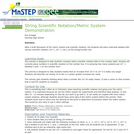
Short demonstration on scientific notation by asking students to place numbers on a number line using string and notecards.

A unit is a frequently arbitrary designation we have given to something to convey a definite magnitude of a physical quantity and every quantity can be expressed in terms of the seven base units that are contained in the international system of units. Hank thinks this is a thrilling subject, and while you may not agree, it is a subject that is very important if you want to be a scientist and communicate with accuracy and precision with other scientists. So listen up and learn something or Hank might have to kill you! (NOT REALLY!)
Chapters:
Unit Conversion
Scientific Notation
Sig Figs

A Khan Academy module that offers instruction and practice problems in exponents and scientific notation.
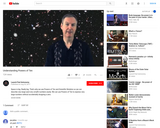
A short video that briefly explains the concept of powers of ten and scientific notation using money as an analogy.